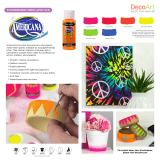
3M
™
Dyneon
™
Fluoroelastomer Compounding Guide
3
Introduction
Components created with 3M
™
Dyneon
™
Fluoroelastomer compounds have the potential to
increase the durability, reliability, and safety of your products – provided that they are made
using the proper materials and processes for the application at hand. Variations in the ratios
of inorganic bases, ller systems and cure systems used in compounding can yield signicant
control over the physical and rheological properties of the resulting compounds – including
properties such as mold ow and mold release that are critical for many applications.
This manual provides general guidelines that can be used as reference in compounding
uoroelastomers. In addition to data regarding the physical properties yielded by various
compounds and processes, the eects of potential contamination and the general
requirements of certain types of applications (such as O-rings, molded goods, and extruded
compounds) are also discussed. For more specic guidelines for the materials used in specic
applications, refer to the 3M
™
Dyneon
™
Fluoroelastomer Recipe Book.
General Compounding
The basics of choosing the polymer and cure system and compounding those systems with the
proper acid acceptors and llers to fulll the rheological, physical and processing requirements
are, in general, relatively simple. This is due to the limited number of ingredients that are able to
withstand the harsh chemical or thermal environments that uoroelastomers are exposed to.
General Compounding Ingredients (PHR)*
Fluoroelastomer 100
Acid Acceptor(s) 6-20
Filler 0-80
Processing Aids 0-2
Curatives (May be incorporated in polymer) 1-4
Bases
(Acid Acceptors)
Inorganic bases commonly used in compounding
uoroelastomers include the following:
CaO Calcium Oxide, HP-XL HallStar
®
Ca(OH)
2
Calcium Hydroxide, HP-XL HallStar
®
MgO Magnesium Oxide, Elastomag
®
170
MgO Magnesium Oxide, Maglite Y HallStar
®
MgO Magnesium Oxide, Maglite D HallStar
®
ZnO Zinc Oxide, USP #1
Inorganic bases aect both the rheological and the physical properties. The best balance of
properties will be achieved by using a combination of calcium hydroxide and magnesium oxide.
The following tables illustrate the change in properties resulting from variations in the ratio of
calcium hydroxide and magnesium oxide.
The general compounding data was generated in our Application and Product Development
Laboratory and should be used only as a guide for compounding. Potential dierences may
arise due to dierences in raw materials and processing techniques. Materials should be
processed and evaluated in the consumer’s facility to verify the properties.
*Parts per Hundred Rubber
Note:
The purpose of this guide
is to provide basic information to
product users for use in
evaluating, processing, and
troubleshooting their use of
certain 3M products. The
information provided is general
or summary in nature and is
oered to assist the user. The
information is not intended to
replace the user’s careful
consideration of the unique
circumstances and conditions
involved in its use and processing
of 3M products. The user is
responsible for determining
whether this information is
suitable and appropriate for the
user’s particular use and intended
application. The user is solely
responsible for evaluating third
party intellectual property rights
and for ensuring that user’s use
and intended application of 3M
product does not violate any third
party intellectual property rights.




















